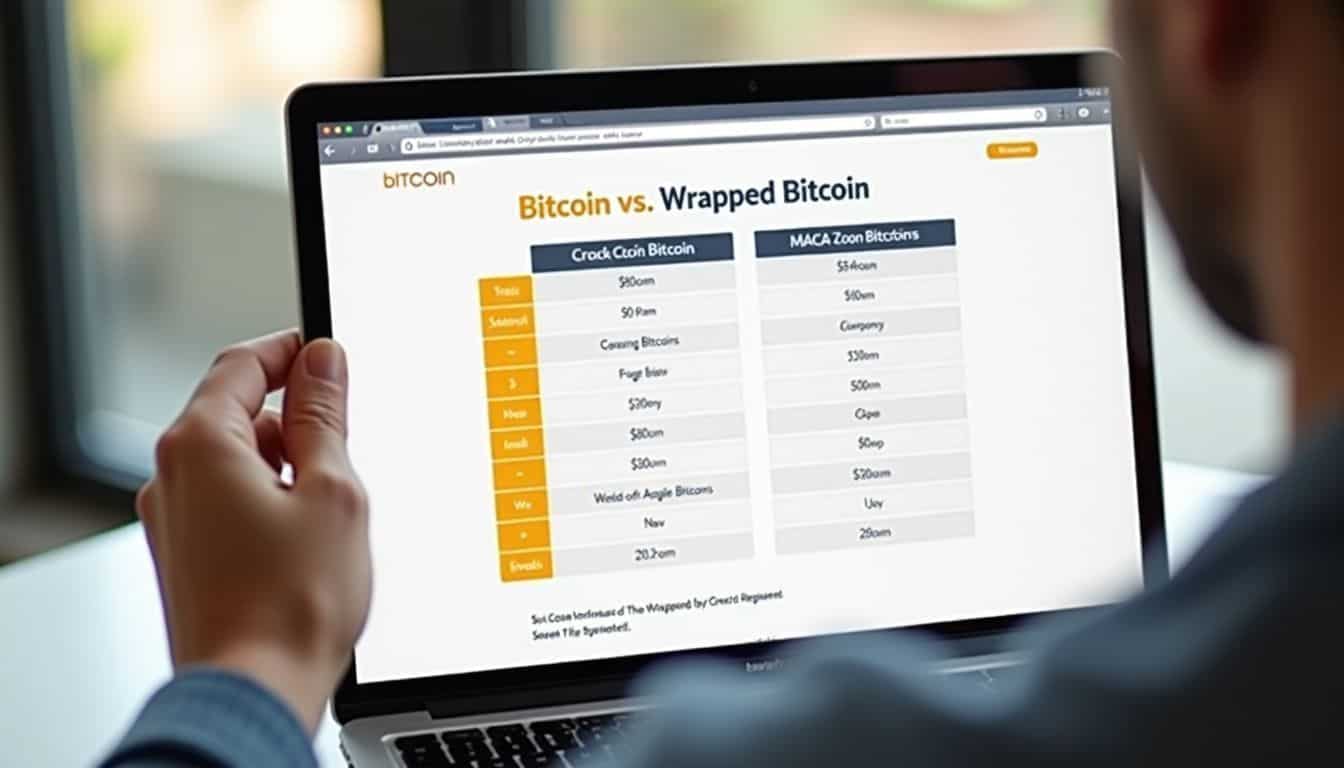Many crypto users struggle to grasp the difference between wBTC and BTC in DeFi trading. Bitcoin remains the most popular crypto asset, with over 19.7 million BTC in use today. This guide breaks down how wrapped bitcoin works on the Ethereum blockchain and its role in DeFi gains.
Get ready to master wrapped tokens and boost your crypto trading skills.
Key Takeaways
BTC runs on its own blockchain with 19.7 million coins in use, while wBTC operates as an ERC-20 token on Ethereum’s network.
BitGo, Kyber Network, and Ren created wBTC in January 2019, with each token backed 1:1 by real Bitcoin. The system now has over 153,000 tokens in use and $8.8 billion Total Value Locked by mid-2024.
Bitcoin transactions take 10 minutes to confirm, but wBTC moves faster on Ethereum at 12–15 seconds per block. This speed makes wBTC better for DeFi trading.
Users can stake wBTC in DeFi apps to earn interest, provide liquidity, or use it as loan collateral. The market value hit $5.52 billion in August 2022.
While wBTC offers more DeFi options, it faces risks from custodians like BitGo and potential smart contract bugs. Users must trust third parties to maintain proper Bitcoin reserves.
Table of Contents
What is Bitcoin (BTC)?

Bitcoin stands as the first digital currency created by Satoshi Nakamoto in 2009. This peer-to-peer network runs on blockchain technology, allowing direct transfers without banks or middlemen.
The total supply caps at 21 million BTC, making it rare and valuable like digital gold. Users can check current rates through various tools like the WBTC to FTM calculator for real-time values.
Bitcoin leads the crypto market with a $1.37 trillion market cap, holding 53.46% of total crypto value. The network has 19.7 million BTC in circulation, tracked through a public ledger system.
My first Bitcoin trade taught me its core strengths: security through cryptography, freedom from central control, and protection against inflation.
What is Wrapped Bitcoin (wBTC)?

Wrapped Bitcoin (wBTC) stands as an ERC-20 token that runs on the Ethereum blockchain. BitGo, Kyber Network, and Ren created this digital asset in January 2019. Each wBTC token holds a direct match to one Bitcoin, making it a perfect bridge between Bitcoin and Ethereum networks.
The WBTC DAO manages this system through 17 key stakeholders and more than 40 active members. Smart contracts keep track of every wBTC token, which shows strong growth with over 153,000 tokens now in use.
DeFi platforms have embraced wBTC as a vital tool for lending, borrowing, and yield farming. Users can lock their wBTC tokens into various DeFi apps, pushing the Total Value Locked past $8.8 billion by mid-2024.
The market value hit $5.52 billion USD in August 2022, proving its wide adoption in decentralized finance. The next section breaks down the main features that set BTC and wBTC apart from each other.
Key Differences Between Bitcoin and Wrapped Bitcoin

Bitcoin and Wrapped Bitcoin have different core technology, token standards, speed, and uses – understanding these key aspects helps make better DeFi decisions.
Blockchain Technology

BTC and wBTC operate on two distinct blockchain networks. The native Bitcoin blockchain uses a proof-of-work system to verify transactions and maintain security. Each network serves different purposes – BTC’s blockchain focuses on peer-to-peer transfers, while wBTC lives on Ethereum’s smart contract platform.
The true power of blockchain lies in its ability to bridge different networks and create new possibilities
The technical differences shape how users interact with these assets. BTC transactions must wait for block confirmations on the Bitcoin network, which takes about 10 minutes per block.
The Ethereum blockchain, where wBTC exists as an ERC-20 token, processes blocks every 12 seconds. This speed boost lets DeFi users move faster with lending, trading, and yield farming on decentralized exchanges.
Smart contracts on Ethereum enable these advanced features that are not possible on Bitcoin’s simpler blockchain.
Token Standard (Native vs. ERC-20)

Beyond blockchain differences, token standards play a vital role in how these digital assets work. Bitcoin runs as a native coin on its own network, much like how CKB price prediction affects its native chain.
The native BTC format allows direct peer-to-peer transfers without extra layers or wrapping processes.
WBTC exists as an ERC-20 token on the Ethereum blockchain, following strict smart contract rules. This ERC-20 standard makes WBTC compatible with Ethereum’s DeFi apps and decentralized exchanges.
The 1:1 peg to Bitcoin means each WBTC token backs up with one real Bitcoin, stored by approved custodians. Users can swap between BTC and WBTC through partner exchanges that maintain this fixed ratio.
Transaction Speed and Fees
 Transaction speeds differ greatly between BTC and wBTC networks. Bitcoin transactions need about ten minutes for block confirmation on its native blockchain. The wBTC moves faster on the Ethereum blockchain, taking just 15 seconds to confirm blocks.
Transaction speeds differ greatly between BTC and wBTC networks. Bitcoin transactions need about ten minutes for block confirmation on its native blockchain. The wBTC moves faster on the Ethereum blockchain, taking just 15 seconds to confirm blocks.
These quick confirmations make wBTC more practical for daily trades and DeFi activities.
Network fees vary based on blockchain traffic and market conditions. BTC fees stay on the Bitcoin network, while wBTC fees go to Ethereum miners or validators after the PoS upgrade.
The Ethereum blockchain handles wBTC transactions more efficiently through smart contracts. Users must consider gas fees on Ethereum to make cost-effective choices for their crypto trades.
The key benefits that wBTC brings to the DeFi ecosystem include:.
Use Cases and Applications

Bitcoin and Wrapped Bitcoin serve different purposes in the crypto space. BTC works as digital money and stores value, while wBTC opens doors to DeFi opportunities. Users can stake wBTC in various DeFi protocols to earn interest or provide liquidity on decentralized exchanges like Uniswap.
Smart contracts on the Ethereum blockchain make these DeFi activities possible and secure. BTC holders can put their coins to work instead of just storing them in wallets. They gain access to lending markets, liquidity pools, and yield-generating strategies without selling their Bitcoin.
The process stays simple – users deposit BTC, receive wBTC, and start earning passive income through various DeFi protocols.
Access to Decentralized Finance (DeFi)

DeFi platforms give Bitcoin holders new ways to grow their money. Users can lend BTC, earn interest, and join yield farming pools through wBTC on Ethereum. The Total Value Locked in DeFi hit $8.8 billion by mid-2024, showing strong demand for these services.
Popular platforms like Compound and Uniswap let users stake their wBTC to earn rewards.
Smart contracts on Ethereum make these DeFi activities possible and secure. BTC holders can put their coins to work instead of just storing them in wallets. They gain access to lending markets, liquidity pools, and yield-generating strategies without selling their Bitcoin.
The process stays simple – users deposit BTC, receive wBTC, and start earning passive income through various DeFi protocols.
Improved Liquidity on Ethereum

Moving beyond basic DeFi access, wBTC plays a vital role in boosting Ethereum’s liquidity pools. The Ethereum blockchain now holds over $8.8 billion in total value locked through various trading platforms and decentralized exchanges.
Smart contracts make it easy to swap wBTC with other ERC-20 tokens in these pools.
Liquidity is the lifeblood of any financial market – crypto or traditional – CryptoTrader Magazine
Trading wBTC on Ethereum creates deeper markets and tighter spreads for traders. Users can stake their wrapped bitcoin in yield farming protocols or provide liquidity to earn passive income.
The increased liquidity has made the market more stable and efficient for both small and large trades. Centralized and decentralized exchanges benefit from the extra trading volume that wBTC brings to their platforms.
Cross-Chain Interoperability

Beyond boosting Ethereum’s liquidity, wBTC opens doors to cross-chain operations. The Zeus Network Bridge plans to connect Solana and Bitcoin in Q3 2024, making digital asset transfers smoother across platforms.
Users can move their crypto assets between different blockchains without complex steps or high fees. Interlay’s decentralized bridge now links Bitcoin to Polkadot, expanding wBTC’s reach in the DeFi space.
Smart contracts power these cross-chain bridges, creating a web of connected blockchain networks. The bridges work like digital translators, helping different chains talk to each other.
This setup lets Bitcoin holders join DeFi projects on Ethereum, Solana, and Polkadot. Users can swap, lend, or stake their wBTC across various platforms while keeping their original Bitcoin safe.
Limitations of Wrapped Bitcoin (wBTC)

While wBTC opens new doors for DeFi gains, users must stay alert to its risks like custody issues and smart contract bugs – read on to learn the full story about these limitations and how to protect your crypto assets.
Custodian Risks
Custodian risks pose serious threats to wBTC holders. Centralized exchanges and decentralized organizations control the Bitcoin reserves that back wBTC tokens. These custodians handle the minting and burning of wBTC, making them crucial gatekeepers.
I learned this firsthand after dealing with a major exchange that temporarily suspended wBTC withdrawals due to liquidity issues. The 1:1 peg between wBTC and BTC depends on proper management by these custodians.
Security breaches or custodian insolvency could break the wBTC-BTC link. Users must rely on these third parties to maintain adequate Bitcoin reserves and protect them from hacks. Converting crypto to cash becomes impossible if custodians fail to process redemption requests.
My experience shows that dealing with custodians adds an extra layer of risk compared to holding regular BTC in a personal cryptocurrency wallet.
Security Concerns
Beyond custodial risks, security threats pose real challenges for wBTC holders. Smart contract bugs on the Ethereum blockchain could expose users to potential hacks or exploits. The minting and unwrapping process of wBTC involves multiple steps through different platforms, which creates more attack points for malicious actors.
BitGo’s role as the main custodian adds another layer of risk, as any security breach in their systems could affect all wBTC holders.
Technical glitches during token transfers or smart contract interactions might lead to permanent loss of funds. The transaction errors that pop up during minting and unwrapping can trap users’ assets in limbo.
Market volatility combined with DeFi protocol vulnerabilities puts wBTC users at higher financial risk than regular BTC holders. The cross-chain nature of wBTC operations makes security audits more complex and harder to maintain.
Risk Management Strategies and Future Considerations
Review comprehensive risk management practices when managing cryptocurrencies. Identify strategies to protect your bitcoins and wrapped bitcoin using measures such as regular smart contract audits and due diligence on custodians. Evaluate blockchain interoperability and market volatility on the Ethereum blockchain, and monitor block times and transaction speed differences across trading platforms.
Study case studies on lending and borrowing and yield farming in decentralized finance. Follow updates from the WBTC DAO and research from Kyber Network to learn effective risk management tactics. Have you experienced differences in block times or transaction speed challenges on various cryptocurrency exchanges? Share your findings with fellow hodlers to strengthen risk management within decentralized applications (dapps) communities.
People Also Ask
What’s the main difference between BTC and wBTC?
BTC runs on the Bitcoin blockchain, while wBTC is an ERC-20 token on the Ethereum blockchain. Think of wBTC as Bitcoin wearing an Ethereum costume to work with smart contracts and decentralized applications.
How can I use wBTC in decentralized finance?
You can use wBTC for yield farming, lending, and borrowing on trading platforms. It works with many crypto wallets and lets you earn interest through DApps, unlike regular Bitcoin.
Is it safe to convert my Bitcoin to wBTC?
Yes, wBTC is safe because it’s backed 1:1 by Bitcoin. The wBTC DAO and know-your-customer rules help prevent fraud. You can check this on the blockchain anytime.
Where can I buy or trade wBTC?
You can get wBTC through cryptocurrency exchanges, using U.S. dollars, bank transfers, or even credit cards. Popular platforms include those supporting the Binance Smart Chain.
Does wBTC have the same value as Bitcoin?
wBTC closely follows Bitcoin’s price because it’s pegged to BTC. Market volatility affects both the same way, though small price gaps can happen during heavy trading.
What are the benefits of using wBTC over BTC?
wBTC offers faster transaction speed through the Ethereum blockchain. It works better with decentralized applications (dapps), NFTs, and DeFi tools. Plus, you can use it for leverage trading and contracts for difference.
References
https://www.morpher.com/blog/wrapped-bitcoin-vs-bitcoin
https://www.coinsmart.com/blog/bitcoin-vs-wrapped-bitcoin-what-are-the-differences/
https://www.gemini.com/cryptopedia/wbtc-what-is-wrapped-bitcoin
https://www.litefinance.org/blog/for-beginners/what-is-wrapped-bitcoin/
https://www.nydig.com/research/risks-and-rewards-with-changes-to-wbtc
Disclaimer: This content is informational and should not be taken as financial advice. Data and analysis are based on publicly available sources and research. No sponsorships or affiliate relationships influence the content. Readers should perform their own verification before making investment decisions.
